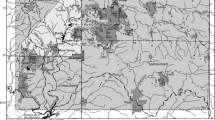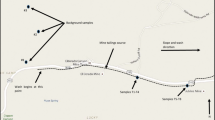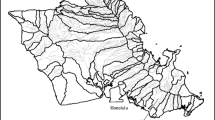Abstract
Waterfowl on lateral lakes of the Coeur d'Alene River and on Lake Coeur d'Alene have been poisoned for many years by lead (Pb) from mining and smelting. In 1992 we undertook a study in the area to determine the importance of sediment ingestion in exposing wood ducks (Aix sponsa) to Pb. Digesta were removed from the intestines of wood ducks collected from contaminated and reference areas. The mean Pb concentration in the digesta of wood ducks from the contaminated area was 32 p.p.m. dry weight. The sediment content was estimated to average less than 2% of the dry weight of the wood duck diet. The lead concentrations in the digesta were closely correlated with the concentrations of acid- insoluble ash, Al, Ti and Fe in the digesta and these four variables are associated with sediment. Samples containing low concentrations of these variables also had low concentrations of Pb. These results suggest that most of the Pb in the digesta came from ingested sediment, rather than from plant material in the diet. The importance of ingested sediment as a source of lead was unexpected, because wood ducks are surface feeders on aquatic plants and they rarely dabble beneath the surface or feed on the bottom. However, it appears that sediment ingestion is sometimes the principal route of exposure to environmental contaminants that are not readily taken up by plants and invertebrates and this route should be considered in risk assessments of waterfowl
Similar content being viewed by others
References
Beyer, W. N., Spann, J. W., Sileo, L. and Franson, J. C. (1988) Lead poisoning in six captive avian species. Arch. Environ. Contam. Toxicol. 17, 121–30.
Beyer, W. N., Connor, E. E. and Gerould, S. (1994) Estimates of soil ingestion by wildlife. J. Wildl. Manage. 58, 375–82.
Blus, L. J., Henny, C. J., Hoffman, D. J. and Grove, R. A. (1991) Lead toxicosis in tundra swans near a mining and smelting complex in northern Idaho. Arch. Environ. Contam. Toxicol. 21, 549–55.
Blus, L. J., Henny, C. J., Hoffman, D. J. and Grove, R. A. (1993) Accumulation and effects of lead and cadmium on wood ducks near a mining and smelting complex in Idaho. Ecotoxicology 2, 139–54.
Cherney, J. H., Robinson, D. L., Kappel, L. C., Hembry, F. G. and Ingraham, R. H. (1983) Soil contamination and elemental concentrations of forages in relation to grass tetany. Agron. J. 75, 447–51.
Chupp, N. R. and Dalke, P. D. (1964) Waterfowl mortality in the Coeur d'Alene River Valley, Idaho. J. Wildl. Manage. 28, 692–702.
Connor, E. E., Scanlon, P. F. and Kirkpatrick, R. L. (1994) Bioavailability of lead from contaminated sediment in northern bobwhites, Colinus virginianus. Arch. Environ. Contam. Toxicol. 27, 60–3.
Elias, R., Hirao, Y. and Patterson, C. (1977) Impact of present levels of aerosol Pb concentrations on both natural ecosystems and humans. In T.C. Hutchinson (ed) International Conference on Heavy Metals in the Environment, Vol. 2, Part 1, pp. 257–71. Toronto, Ontario: Institute for Environmental Studies, University of Toronto.
Henny, C. J., Blus, L. J., Hoffman, D. J. and Grove, R. A. (1994) Lead in hawks, falcons and owls downstream from a mining site on the Coeur d'Alene River, Idaho. Environ. Monit. Assess. 29, 267–88.
Johnsgard, P. A. (1975) Waterfowl of North America. Bloomington, IN: Indiana University Press.
Karasov, W. H. (1990) Digestion in birds: chemical and physiological determinants and ecological implications. Stud. Avian Biol. 13, 391–415.
Krieger, R. I. (1990) Toxicity and Bioavailability Studies of Lead and Other Elements in the Lower Coeur d'Alene River. Boise, ID: Idaho Bureau of Land Management Technical Bulletin 90–3.
US Fish and Wildlife Service (1986) Use of Lead Shot for Hunting Migratory Birds in the United States. Washington, DC: US Fish and Wildlife Service.
Author information
Authors and Affiliations
Rights and permissions
About this article
Cite this article
Nelson Beyer, W., Blus, L.J., Henny, C.J. et al. The role of sediment ingestion in exposing wood ducks to lead. Ecotoxicology 6, 181–186 (1997). https://doi.org/10.1023/A:1018670626114
Issue Date:
DOI: https://doi.org/10.1023/A:1018670626114




